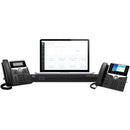Description
The Cisco BE4000 is an easy-to-use, cloud-managed communications platform designed to streamline small and midsize business communications. Built on proven IP telephony and voicemail technology, BE4000 delivers reliable voice, messaging, and collaboration features in a compact, scalable appliance. It is ideal for growing organizations and supports up to 200 phones, enabling a unified communications experience across desks, mobile devices, and conference rooms. With cloud-based management, administrators can configure, monitor, and maintain the system from a single, intuitive interface, reducing IT overhead and accelerating deployment. Whether you need hosted-style flexibility with on-premises control or a hybrid approach, BE4000 helps you reduce communications costs while improving productivity and collaboration across teams.
- Cloud-managed simplicity: Centralized administration from Cisco’s cloud portal enables remote provisioning, bulk configuration, and rapid deployment across multiple locations, reducing IT time and travel. With role-based access, you can assign permissions, track changes, and monitor system health from anywhere, ensuring consistent settings and timely security updates.
- Robust IP telephony and voicemail: Enjoy high-quality voice calls, voicemail, and unified messaging that integrates with email and mobile devices. BE4000 delivers easy call routing, robust voicemail-to-email options, and reliable conferencing features to keep teams connected, even when working remotely or across sites.
- Scalable capacity for growing teams: Supports up to 200 phones with straightforward expansion options as your business grows. The appliance is designed to accommodate increasing user counts, new locations, and evolving communication needs without requiring a full system replacement, helping you protect your initial investment.
- Cost savings and reliability: Consolidates voice services, voicemail, and collaboration into a single, managed platform, lowering total cost of ownership while leveraging Cisco’s proven reliability, security, and support ecosystem. Centralized firmware updates and security patches help reduce maintenance costs and downtime.
- Fast setup and easy integration: Quick deployment with familiar Cisco interfaces, guided setup wizards, and seamless integration with existing network infrastructure. BE4000 supports standard SIP endpoints, gateway connections, and cloud-management workflows, enabling a smooth transition from legacy systems.
Technical Details of Cisco Business Edition 4000 Appliance
- Get this information from the "specifications" section of the product from https://ec.synnex.com/ using product "UPC" or "SKU" as reference
How to install Cisco Business Edition 4000 Appliance
Follow these guidelines to install BE4000 with minimal disruption and a fast path to production. Preparation, careful planning, and a clear deployment roadmap will help you maximize uptime and user adoption.
Step 1: Plan and prerequisites - Assess your office layout, network topology, bandwidth capacity, and QoS requirements. Confirm compatibility with existing routers, switches, and trunk services. Decide on cloud-management preferences, whether you will primarily manage through Cisco’s cloud portal or combine with on-site management tools. Prepare licensing, user accounts, and extension plans ahead of time to streamline provisioning.
Step 2: Prepare the hardware - Unbox the BE4000 appliance, mount it in a secure rack or place it on a stable shelf, and connect power. Ensure proper ventilation and cable management. If you have a multi-site deployment, label cables clearly and plan for remote power for devices in case of outages. Verify that you have the correct power supply and any optional expansion modules ready for install.
Step 3: Connect to the network - Connect the BE4000 management port to a stable Ethernet network with appropriate VLAN tagging if your environment uses VLANs. If you plan to integrate with SIP trunking, connect trunks and gateway interfaces according to Cisco deployment guides. Enable QoS policies to optimize voice traffic and reduce jitter and packet loss for a clearer calling experience.
Step 4: Access the management interface - From a workstation on the same network, access the BE4000 web-based management portal and authenticate using the administrator credentials. Follow the guided setup to configure IP addressing, trunk lines, voicemail, and user extensions. If you are using cloud management, register the BE4000 with Cisco’s cloud management service as required by your licensing model.
Step 5: Configure users, extensions, and features - Create user accounts, assign extensions, configure voicemail boxes, and define call routing rules, IVR menus, and dial plans. Enable advanced features such as voicemail-to-email, call forwarding, presence, conferencing, and integration with collaboration apps. Establish security settings, password policies, and role-based access to protect your system.
Step 6: Add IP phones and devices - Provision IP phones and soft clients, applying device templates for consistent settings and simplified mass provisioning. Ensure each device is licensed correctly and synchronized with user accounts. Test provisioning from the cloud portal or on-site management interface to confirm device reachability and correct extension mapping.
Step 7: Test and monitor - Conduct end-to-end testing: place internal and external calls, test voicemail, conferencing, call routing, and feature workflows across all sites. Monitor performance via the cloud portal or on-site tools, verify security settings, and capture baseline metrics for voice quality (MOS/R factors). Address any issues, fine-tune QoS, and document configurations for future audits and maintenance.
Frequently asked questions
- What is Cisco BE4000? A cloud-managed communications system designed for small to midsize businesses, combining IP telephony, voicemail, and collaboration in a single appliance.
- How many phones can BE4000 support? Up to 200 phones, with scalable options as your organization grows and additional capacity can be planned through expansion paths.
- Do I need a separate server for BE4000? No on-site PBX server is required; BE4000 is designed to be managed via Cisco’s cloud management portal or a local management interface, depending on deployment choices.
- Is BE4000 compatible with IP phones? Yes, BE4000 supports standard SIP-based IP phones and Cisco endpoints, along with soft clients for desktops and mobile devices.
- How do I get started? Begin with planning and deployment through the web-based setup and cloud management portal, then add users and devices, test, and monitor ongoing performance for continuous improvement.
Customer reviews
Showing - Of Reviews


